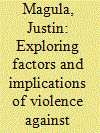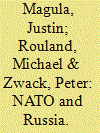|
|
|
Sort Order |
|
|
|
Items / Page
|
|
|
|
|
|
|
| Srl | Item |
| 1 |
ID:
192656


|
|
|
|
|
| Summary/Abstract |
The Soviet-Afghan War serves as a significant case study to understand why states resort to violent acts against civilians during war. This study takes a multidimensional approach, examining strategic, operational, and individual factors and applying theories of violence and mass killing. By analyzing the conditions that led the Soviets to target civilians, this investigation identifies a nexus of interconnected factors. At the strategic level, Soviet leaders pursued a swift victory to establish a Communist client regime while minimizing casualties and controlling information flow. Operationally, the ill-preparedness of the Red Army for counterinsurgency warfare, coupled with an entrenched organizational culture, led to the adoption of counterproductive enemy-centric tactics against Afghan noncombatants. Additionally, inadequate training, prolonged deployments, and a lack of disciplinary measures at the individual level contributed to the perpetration of violent acts. Understanding the underlying causes of violence against civilians, particularly in the context of Russian forces, holds practical importance. This knowledge can assist policymakers in devising strategies that mitigate wartime violence and enhance the protection of citizens. Drawing parallels to contemporary conflicts involving Russia, the study concludes by recommending future research directions and emphasizing the relevance of comprehending the targeting of noncombatants in ongoing conflicts, notably the Russian-Ukrainian conflict.
|
|
|
|
|
|
|
|
|
|
|
|
|
|
|
|
| 2 |
ID:
186538


|
|
|
|
|
| Summary/Abstract |
Over the past decade, the North Atlantic Treaty Organization (NATO) has undertaken a strategic transformation to address various threats against the Alliance. Amongst those threats, Russia poses the most inimical and immediate challenge in terms of time, geography, and intent. Following Russia’s 2022 invasion of Ukraine, what could a strategic policy toward Russia for the next decades look like? What is needed to deter aggression against allies across all domains, to deter below the threshold of armed conflict and to de-escalate and terminate conflict above the threshold?
|
|
|
|
|
|
|
|
|
|
|
|
|
|
|
|
|
|
|
|
|